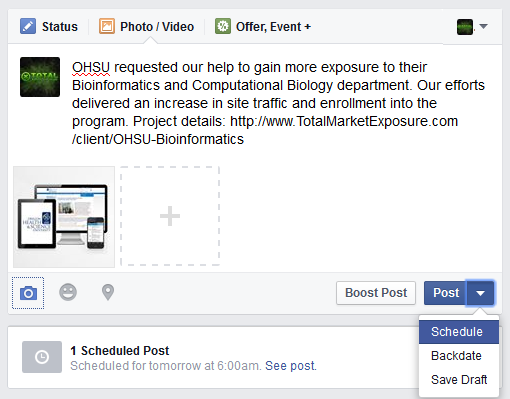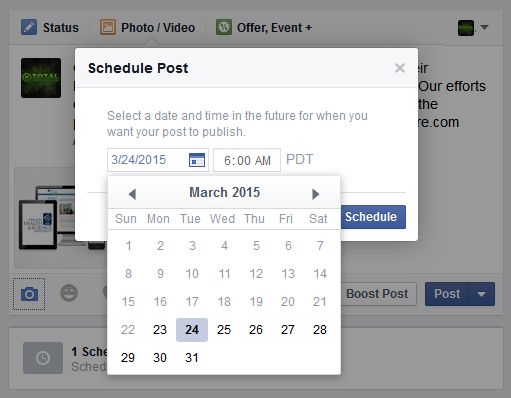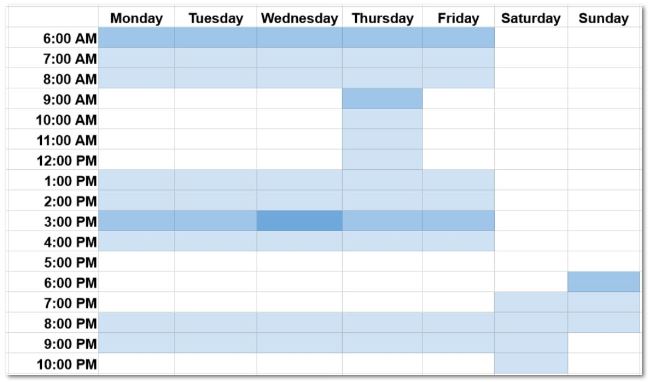The golden rule for Facebook is that there is no golden rule. Every person is different in some way and every business is different too, so there are very few rules set in stone. However, that doesn’t mean certain Facebook tips and techniques are not useful for the majority of business pages. Having social media success on Facebook is kind of like cooking in that everyone has different tastes and you can have all the right ingredients, but if you mix it wrong, skip steps, cut corners, under-cook, over-cook, or forget key ingredients, it might not taste very good. So let’s talk about a few Facebook business page tips to help you reach your audience and achieve success.
Facebook Business Page Tips
- Plan your posts in advance. Facebook posting is usually one of the first things to be ignored when we get busy. Most business owners don’t have the time to devote every day to Facebook posting. If that’s you, we recommend you set aside at least a few hours each week to schedule Facebook posts. You can use the Facebook post scheduling feature plus there are several other great social media tools available that can help with scheduling and content curation. One of my favorite social media tools is called Bundle Post so I recommend you check them out if you’re looking for help in those areas. If not, here are a couple images that show you how to schedule Facebook posts one by one. First, click on the arrow next to the “Post” button, then click “Schedule” and select a date and time.
- Integrate. Leverage your website, email lists, print collateral, direct message and other channels to create your following. Do not expect your friends, family, colleagues or patrons to notice you or your page “invite” amongst the mass of notifications we all receive daily. Driving current customers and brand advocates to your page is a great way to build with a solid foundation.
- Share other people’s relevant content. When you are in a real social setting, not every conversation is all about you. The same concept applies to social media. Sharing content from other people and business pages is a great way to actually be social. This also increases user engagement and encourages the cross promotion of your content. Try to find parallel brands and/or companies that do not directly compete with you but have a similar like-minded audience. Here’s a link to a previous article that shows you how to share a Facebook post as your business page. Doing this can also help your own content stand out just a little bit more because your audience won’t be drowning in posts that are always about your business or services.
- Be proactive, not reactive. This will almost always be true no matter what the situation. We recommend outlining both positive and negative response plans that address top areas of concern. Another way you can do this is to post a Q&A page on your website and share the link on your profiles or within comments when necessary. Having a Q&A page ready can be a huge time saver.
- Be creative. Try to have a little fun with it. Post industry humor, trivia or simply ask a question to spark the engagement you’re looking for. Just remember, not everyone will like every post or every joke, but that’s OK as long as you learn from it.
- Think before you post. It’s important that you error on the side of caution when addressing sensitive topics on your business page. Posting the wrong thing at the wrong time can be disastrous. Be aware of what is happening around you such as local tragedies, national outcries or natural disasters, and think about what reaction you may receive before you post sensitive content that may cast a bad light on your business.
- Post at the right time. Timing is everything. We’ve all heard this before, but it’s especially true for social media and the best time to post on Facebook may be different for each individual company. To give you a starting point for posting at the right time, below is an image of the most common peak traffic times on Facebook. You’ll see that the early AM may be a good time to schedule posts because many people wake up and check their Facebook before starting work. The second main peak volume time is in the afternoon when people start wrapping up their day or are getting off work. The best time to post on Facebook will vary and there are many exceptions to this guide as we’ve previously stated. Things such as local events or various industries may have different peak times based on the audience. The best way to know for sure is to try it, track it and adjust accordingly. In the image below, you with see a compilation of best times according to several sources with the peak volume times are darker and the slower times are lighter.
- Be respectful. Being pushy, spammy or over pitching your services can shine a bad light on your brand. Sometimes less is more, like Hashtags.
- Keep it short. Social media is not a blog! Most people using social media don’t want to read a book, hence the popularity of Twitter. If you have to click “See More” to finish reading the post, it’s probably too long. Occasionally it is not bad but if you’re doing this several times per month, stop. Make it short and sweet!
- Do not over share. Post quality over quantity. No one likes spam and over posting can come across as desperate or spammy. The larger your audience the more you can post.
- A Picture is worth 1,000 words. People love pictures because they tell the story visually. Posting a good picture with short description and a link with a call to action can be very effective. The key is to make sure the picture and text actually depicts what visitors will see when they visit the page. Facebook’s algorithm tracks how long people stay on a site after clicking on an external link by monitoring how long it takes them to return to Facebook. If they bounce quickly for any reason, Facebook will assume that the image post is link-bait and restrict the number of people who see the post. This means the image and text needs to be relevant to linked content.
- Post videos. Videos are a great way to engage your audience. Many studies have proven that people remember a product or brand from a video more than text or images. In addition, Facebook has recognized that videos are more powerful and has openly said that videos will receive more exposure than other forms of posting.
- Use existing images, data and experience. You’ve probably invested a lot of time and money into what you already have, so let’s use it. You know better than anyone what your top products/services are and all the cool features. Posting a good product picture with a short text line about one popular feature with a link to more info or a purchase page is great. Then just wait a while (a few weeks or months depending on post frequency) and post the same image again, only this time use a different text line about a different product feature. This way you get the most out of your previous content investments plus you can test what product features and taglines motivate the highest level of engagement.
- Track results. It is very important to track all available data, not just Facebook insights. If you don’t know what’s working, it’s very difficult to make improvements. Monitor your Facebook insights, traffic behavior from social (i.e. Google analytics), conversions rates and asking friends for feedback can really help you improve results.
- Interact with your community. Respond to comments and messages as quickly as possible. To build trust and improve relationships, it’s important for followers to know that you’re there and that you care. If someone asks a question in the comments, responding quickly could make all the difference in the world. And it’s not just the person who asks the question either, other followers see how fast you respond and it can add value or hurt your cause depending on how timely you respond.
- Quality over quantity. Strive for real loyal followers and not thousands of fake users. Do not fall for the “Get Likes Quick” scam. Gain followers the old fashioned way, by earning them. We discuss this in step two (2) and it should not be something you do once. Stay diligent and add it to your repertoire to build followers organically. In addition, try to create or find quality content that may actually be helpful to the people you want to interact with.
- Know your voice. Understanding your brands voice is important. Knowing your voice means understanding your tone, personality and value proposition. This is good to think about because most of the time your followers will not be hearing your actual voice so being able to convey tone and personally will go a long way. It will help you personalize content as well.
- Personalize. Be genuine and speak to your audience. Posting the same “buy, buy, buy” message over and over doesn’t do any good. It’s OK to post products, deals or specials, but just make sure that’s not all you post. Add a personal touch to it so you connect with followers. For example; if you run a fishing charter company, share fish stories and fun memories, or if you own a jewelry business, talk about how it felt when you received your first piece of jewelry. It’s important to remember that people use Facebook, not robots (at least most of the time). This will help you create stronger relationships.
- Research your competition. Research other brands and look and what the competition is doing. This can help you find out what’s working, what’s not and how to better differentiate your brand. Understanding how you are different and what needs your brand/products fulfills compared to the competition can help you convey that to your followers. Plus it can also give you some great ideas for content and help you with your overall strategy.
- Share your own posts. Posting to your Facebook business page and then sharing it to your personal profile is a great way to get more exposure within your personal network. I recommend that you post on your business page during peak A.M. traffic times and then share to your personal profile in peak afternoon times. This will allow your post to gain traction on your business page organically and then gain even more momentum after. If you choose to do this, make sure you don’t share every post to your personal profile because it will start to get old and your friends probably don’t want to see that everyday.



Final Thoughts
Facebook can be a very powerful tool for businesses. If used correctly, it can help you reach new potential customers and keep in touch with patrons. The Facebook ad platform is also a very powerful tool if you target the right audience. One of the biggest mistakes I see people make is running ads without researching the target audience thoroughly. Doing this will help improve conversions and reduce cost per acquisition. Keep in mind that Facebook has over a billion users that generate trillions of impressions so it’s best to narrow down your demographic and geographic location when targeting ads. You can always expand as you move forward and we’ll talk more about targeting Facebook ads in a later post. Until then, please remember that Facebook is constantly changing their page functions and features so I recommend you take their tours as they appear. They do this so you can see use the new additions or changes as they update.
As always, thanks for reading and I hope you found something useful in this list of Facebook business page tips. Stay tuned for more marketing tools and tips.
Resources:
Bundle Post
How to Like, Comment & Share as Your Business Page
Social Media Today
We-Are-PDX
Marketing Land
Tags: Best Time to Post on Facebook, Business Page, Facebook, Facebook Tips, Scheduling Facebook Posts, Tips
